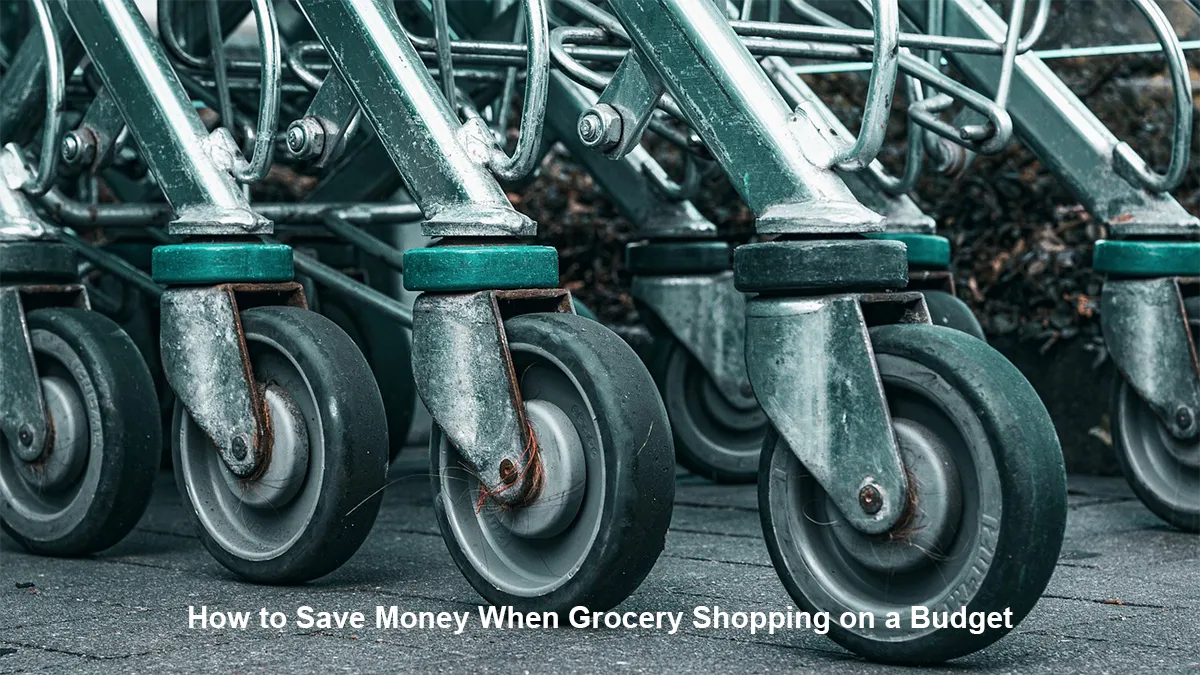How to Save Money When Grocery Shopping on a Budget, 19 ways

Since you decided to read this post, you want to reduce your expenses to save money. Where the cost of living continues to rise, grocery shopping on a budget has become an essential skill for many households. With careful planning and strategic shopping habits, you can significantly reduce your grocery expenses without compromising on quality or nutrition. Now How to Save Money When Grocery Shopping on a Budget:
1. Check Your Pantry
Before heading out to the grocery store, take a thorough inventory of what you already have in your pantry and refrigerator. This step is crucial for several reasons. First, it prevents unnecessary purchases of items you may already own. For instance, if you find a half-full jar of pasta sauce or a bag of rice hiding in the back of your pantry, you can incorporate these ingredients into your meal plans instead of buying more.
Additionally, understanding what staples you have allows you to utilize them effectively and creatively in your cooking. By doing so, not only do you save money but also reduce food waste—a significant issue in many households. Make it a habit to regularly check expiration dates and rotate items to ensure that nothing goes unused.
2. Plan Your Meals
Once you’ve assessed what’s already in your kitchen, it’s time to plan your meals for the week ahead. Meal planning is one of the most effective strategies for saving money while grocery shopping because it provides structure and direction. Start by selecting recipes that incorporate the ingredients you already have; this not only maximizes your existing resources but also minimizes additional expenses.
When creating your meal plan, consider versatile ingredients that can be used across multiple dishes—such as chicken breasts or seasonal vegetables. Additionally, look for sales or seasonal produce that can add variety without breaking the bank. Websites and apps dedicated to meal planning can offer inspiration and help streamline this process. Ultimately, having a clear plan reduces impulse buys and helps maintain focus during shopping trips.
3. Write a List
With your meal plan in hand, the next step is crafting a detailed grocery list based on the ingredients needed for those meals. Writing a list is not just about organization; it also serves as a powerful tool against overspending and impulse purchases at the store. Stick to your list as closely as possible when shopping—this discipline will keep you aligned with your budget goals.
To enhance efficiency while shopping, categorize items on your list according to the layout of the store (e.g., produce, dairy, meat). This way, you’ll avoid backtracking and save time during your grocery run. Additionally, consider taking advantage of digital grocery lists or apps that allow for easy modifications as needed throughout the week.
4. Shop the Sales
One of the most straightforward ways to save money when grocery shopping is to take advantage of sales and promotions. Many grocery stores regularly offer discounts on various items, particularly on items nearing their expiration dates or seasonal products. To maximize your savings:
- Plan Your Meals Around Sales: Before heading to the store, check local flyers or online advertisements for upcoming sales. Build your meal plan around these discounted items.
- Use Coupons: Whether digital or paper, coupons can significantly reduce your grocery bill. Take the time to clip coupons for products you regularly buy.
- Stock Up on Non-Perishables: When essential items like pasta, rice, or canned goods are on sale, consider buying in bulk. This not only saves money in the long run but also ensures you have staples on hand.
By being proactive and planning your shopping trips around sales, you can stretch your budget further than you might expect.
5. Buy Local and in Season
Purchasing local and seasonal produce is not only beneficial for your wallet but also supports local farmers and reduces environmental impact. Seasonal fruits and vegetables are often more abundant and therefore less expensive than out-of-season options.
- Visit Farmers’ Markets: These markets typically offer fresh produce at competitive prices compared to traditional grocery stores. Additionally, you can often negotiate prices with vendors.
- Learn What’s in Season: Familiarize yourself with which fruits and vegetables are currently in season in your area. This knowledge will help you make informed purchasing decisions that align with both freshness and cost-effectiveness.
By prioritizing local and seasonal products, you can enjoy fresher foods while keeping costs down.
6. Incorporate Meatless Meals
Incorporating meatless meals into your weekly diet can lead to significant savings on groceries. Meat is often one of the more expensive items on a shopping list; therefore, reducing its frequency can help manage expenses.
- Explore Plant-Based Proteins: Beans, lentils, tofu, and chickpeas are all affordable protein sources that can be used in a variety of dishes. Experimenting with different recipes not only provides nutritional benefits but also introduces new flavors into your cooking.
- Meatless Monday: Consider designating one day a week as “Meatless Monday” where you focus solely on plant-based meals. This simple change can help reduce overall meat consumption without making a drastic lifestyle shift.
Adopting this approach not only benefits your wallet but also promotes a healthier diet rich in vegetables and whole grains.
7. Sign Up for Store Loyalty Programs
Many grocery chains offer loyalty programs that provide exclusive discounts and rewards for regular shoppers. Signing up for these programs is typically free and comes with various advantages:
- Personalized Discounts: Loyalty programs often tailor discounts based on your purchasing habits, allowing you to save more on items you frequently buy.
- Member-Only Promotions: Participating members may have access to special promotions that non-members do not receive.
- Earn Points for Future Purchases: Some stores allow customers to earn points that can be redeemed for discounts on future purchases or even gift cards.
By taking advantage of these programs, you can unlock additional savings that contribute significantly to your overall grocery budget.
8. Use Savings Apps and Coupons
One of the most effective ways to save money while grocery shopping is by leveraging technology. Savings apps have become increasingly popular, offering users access to discounts and cashback opportunities at their favorite stores. Platforms like Ibotta, Rakuten, and Honey provide users with the ability to find deals tailored to their shopping habits.
In addition to apps, don’t forget the power of traditional coupons. Many grocery stores still honor manufacturer coupons and have their own loyalty programs that offer exclusive discounts. Take some time each week to clip coupons from newspapers or print them online. Combining these savings with in-store promotions can lead to significant reductions in your total bill.
9. Time Your Shopping Right
The timing of your grocery trips can greatly influence how much you spend. Consider shopping during off-peak hours or mid-week when stores are less crowded, and promotional items may be more abundant. Additionally, many retailers mark down products nearing their expiration date during late evening hours or on certain weekdays; being flexible with your schedule can result in substantial savings.
Moreover, pay attention to seasonal sales cycles. Stocking up on certain items during holidays or end-of-season sales can further reduce costs over time. For example, buying canned goods or holiday-themed products after major holidays can yield significant savings.
10. Skip Prepared and Packaged Foods
While convenience is tempting, prepared and packaged foods often come with a hefty price tag compared to their unprocessed counterparts. By skipping these items and opting for whole foods instead, you not only save money but also contribute to a healthier diet.
Invest some time in meal planning and batch cooking to make home-cooked meals more convenient. Preparing your own meals allows you to control ingredients and portion sizes while avoiding unnecessary additives found in processed foods. Simple staples like rice, pasta, beans, and fresh vegetables can form the foundation of nutritious meals at a fraction of the cost.
11. Try Canned and Frozen Foods
Canned and frozen foods are often overlooked but can be excellent budget-friendly alternatives that do not compromise on nutrition or taste. These options are typically less expensive than fresh produce—especially out of season—and they have a longer shelf life.
Canned vegetables and fruits retain most of their nutrients while providing convenience in meal preparation. Similarly, frozen fruits and vegetables are picked at peak ripeness and flash-frozen, ensuring that they maintain their quality over time. Incorporating these into your meal plans can help stretch your budget without sacrificing flavor or health.
12. Stock Up on Deals
One of the simplest yet most effective ways to save money is by taking advantage of sales and promotions. Many grocery stores offer weekly sales that can provide substantial discounts on staple items. To maximize your savings:
- Plan Your Meals Around Sales: Check your local store’s weekly ad before planning your meals. By focusing on items that are on sale, you can create cost-effective meal plans that utilize discounted ingredients.
- Use Coupons: Combine store promotions with coupons for even greater savings. Many stores have digital coupon apps that make it easy to find and apply discounts directly at checkout.
- Keep an Eye Out for Clearance Items: Don’t overlook clearance sections where products nearing their expiration date may be offered at steep discounts. If you can use them right away or freeze them for later use, this can be a great way to save.
13. Look for Private-Label Products
Private-label products are those brands that are sold exclusively by a retailer under its own label, typically at lower prices than national brands. These products often maintain comparable quality but come at a fraction of the cost. Here’s how you can leverage private-label options:
- Experiment with Store Brands: Try substituting name-brand items with store-brand versions. You might find that the taste and quality are just as good—if not better—than their pricier counterparts.
- Focus on Common Grocery Staples: Items such as pasta, canned goods, and frozen vegetables often have great private-label alternatives that can help stretch your budget further.
14. Compare Unit Prices
When shopping for groceries, it’s crucial to look beyond the sticker price and consider the unit price—the cost per ounce or per item of a product. This practice enables you to make informed decisions about which items truly offer the best value:
- Use Price Tags Wisely: Most grocery stores display unit prices alongside regular prices. Use this information to compare different sizes or brands of the same product efficiently.
- Calculate Costs On-the-Go: If you’re uncertain about which option is cheaper while shopping, don’t hesitate to pull out your calculator or smartphone app to do quick calculations before making a purchase.
15. Buy in Bulk
Buying in bulk can lead to significant savings if done wisely. Many bulk items have lower unit prices compared to their smaller counterparts; however, it’s essential to ensure that you will use these items before they expire:
- Identify Non-Perishables: Focus on purchasing non-perishable items in bulk, such as grains, dried beans, canned goods, and frozen foods.
- Share Bulk Purchases: If you’re hesitant about buying large quantities alone, consider teaming up with friends or family members to split bulk purchases. This way, everyone benefits from lower prices without excess waste.
16. Avoid Food Waste
One of the most significant contributors to overspending on groceries is food waste. According to the USDA, an estimated 30-40% of the food supply in the United States goes uneaten. By adopting strategies to minimize waste, you can save a substantial amount of money. Start by planning your meals for the week before heading to the store. Create a shopping list based on those meals and stick to it; this not only helps avoid impulse buys but also ensures that you only purchase items you need.
Additionally, make it a habit to check your pantry and refrigerator before shopping. Incorporate ingredients that are nearing their expiration dates into your meal plans. When cooking, consider using leftovers creatively—transform them into soups, stir-fries, or even salads for lunch the next day. By being mindful of what you already have and using it efficiently, you can significantly reduce food waste and save money.
17. Watch for Product Markdowns
Another effective way to save money at the grocery store is to keep an eye out for product markdowns. Many grocery stores offer discounts on items that are close to their sell-by dates or have been overstocked. These markdowns can be substantial—often ranging from 30% to 50% off regular prices—making them an excellent opportunity for savvy shoppers.
To take advantage of these deals, visit your local store during specific times when markdowns are typically applied—usually early morning or late evening hours when stores are restocking shelves. Additionally, don’t hesitate to ask store employees about upcoming sales or markdown schedules; they may provide insights that can help you plan your shopping trips effectively.
18. Try New Stores
If you’ve always shopped at the same grocery store out of habit, it may be time to explore new options in your area. Different retailers often have varying pricing structures and promotions that can lead to significant savings. Discount grocery chains or warehouse clubs might offer lower prices on staple items compared to traditional supermarkets.
To find the best deals, consider visiting local farmers’ markets as well; they often sell fresh produce at lower prices than supermarkets while supporting local businesses. Don’t forget to compare prices online through various grocery delivery apps or websites before heading out—this will give you an idea of where the best deals can be found.
19. Consider a Rewards Credit Card
While it’s essential to manage your spending wisely, using a rewards credit card strategically can enhance your savings when grocery shopping. Many credit cards offer cash back or points for every dollar spent on groceries—a valuable perk that can add up over time.
However, it’s crucial only to use a credit card if you’re able to pay off the balance in full each month; otherwise, interest charges could negate any benefits gained from rewards programs. Research different options available and choose one that aligns with your spending habits and offers favorable rewards for grocery purchases.
Conclusion
Grocery shopping doesn’t have to break the bank! By implementing these practical tips into your routine, you’ll be well-equipped to make smarter purchasing decisions while still enjoying delicious meals with family and friends—all within budget! Remember: every little saving adds up over time.
Call To Action
What strategies do you use when grocery shopping? Share your tips in the comments below! If you found this post helpful, consider sharing it with friends who might also benefit from saving money during their grocery runs. Best regards, Finance Mate Club





